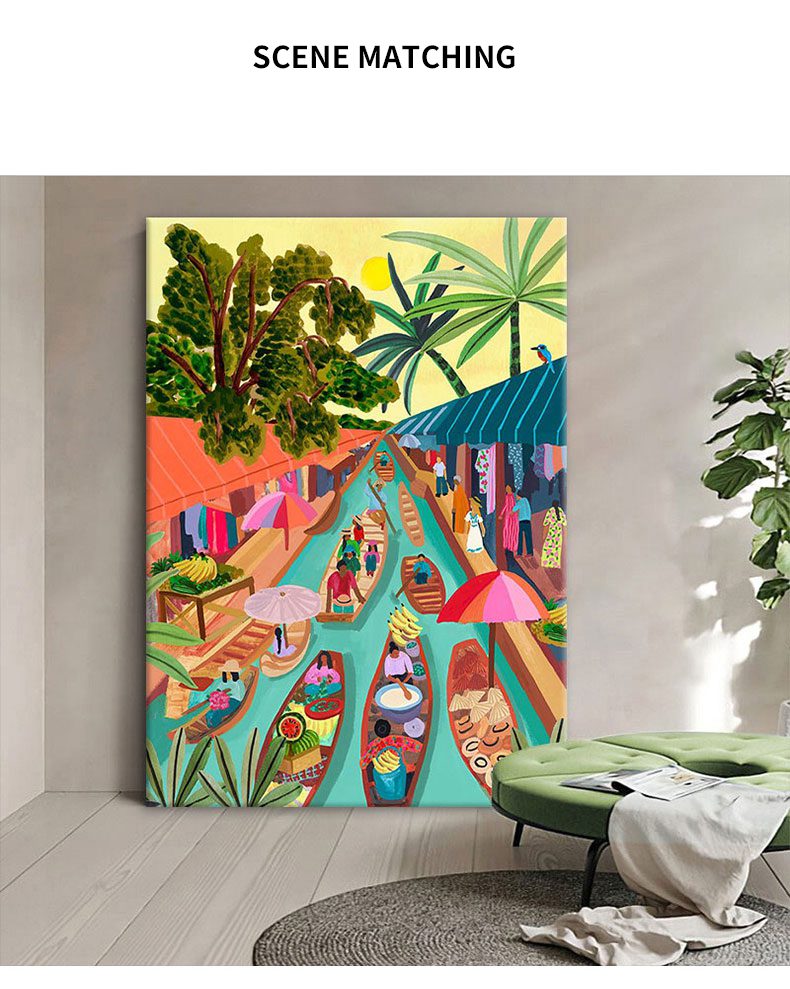Choosing the Right Hand-Painted Oil Painting Styles for Clubhouse Interiors: Enhancing Ambiance and Identity
Clubhouses, whether private social venues, fitness centers, or cultural hubs, rely on their aesthetic appeal to create memorable experiences for members and guests. Hand-painted oil paintings offer a timeless way to infuse personality into these spaces, but selecting the right style requires alignment with the club’s purpose, architecture, and audience. Below, we explore how different artistic approaches can elevate clubhouse environments without compromising functionality or cohesion.
1. Classic Elegance: Timeless Beauty for Formal Spaces
For clubhouses with traditional architecture or a focus on luxury, classic oil painting styles such as Baroque, Renaissance, or Neoclassical can reinforce an atmosphere of sophistication. These works often feature balanced compositions, realistic depictions of human figures or landscapes, and a muted yet rich color palette. A grand portrait of a historical figure in a dining hall or a serene landscape with soft lighting in a lounge area can evoke a sense of refinement and heritage.
The use of gold leaf accents or intricate detailing in classic paintings also adds tactile depth, making them focal points in rooms with high ceilings or ornate moldings. This style works particularly well in heritage buildings or venues aiming to project exclusivity, as it subtly communicates a connection to artistic traditions.
2. Modern Minimalism: Clean Lines for Contemporary Clubhouses
Clubhouses with sleek, modern designs benefit from oil paintings that embrace simplicity and abstraction. Modern minimalist styles focus on geometric shapes, monochromatic schemes, or limited color palettes to create visual harmony. For example, a large-scale abstract piece with bold strokes of black and white can serve as a striking contrast to a minimalist lobby’s clean lines, while a series of small, monochromatic landscapes can add warmth without overwhelming the space.
This approach also aligns with the principles of biophilic design when natural elements are incorporated subtly. A minimalist painting of a single tree branch or a gradient sky can bridge the gap between indoor and outdoor environments, fostering calmness in high-energy areas like fitness centers or coworking lounges.
3. Impressionist Vibes: Capturing Light and Movement for Social Areas
Impressionist oil paintings, characterized by their loose brushwork and emphasis on light, are ideal for clubhouses designed to encourage social interaction. These artworks often depict lively scenes—such as bustling cafés, gardens, or waterfront views—that resonate with the energy of communal spaces. A vibrant impressionist piece in a bar or lounge area can inspire conversation, while softer, pastel-toned works in a spa or relaxation zone can create a dreamy, tranquil atmosphere.
The dynamic quality of impressionist art also helps break up monotony in large, open-plan areas. By incorporating paintings with varying perspectives or seasonal themes, clubhouses can maintain visual interest without cluttering the design. This style is particularly effective in venues hosting events or gatherings, as it reflects the fluidity of human connection.
4. Surreal and Conceptual: Adding Intrigue to Creative Clubhouses
For clubhouses focused on innovation, art, or intellectual pursuits, surreal or conceptual oil paintings can spark curiosity and dialogue. These styles often challenge conventional perceptions through unexpected juxtapositions, dreamlike imagery, or abstract symbolism. A surrealist painting in a library or study area might feature floating objects or distorted figures, encouraging members to interpret its meaning, while a conceptual piece in a gallery space could explore themes like identity or technology through fragmented forms.
This approach is less about matching existing decor and more about creating a narrative. Surreal art can transform neutral walls into thought-provoking backdrops, making it ideal for venues that host lectures, workshops, or cultural events. The key is to balance boldness with restraint—one or two statement pieces per room are often enough to inspire without overwhelming.
5. Cultural and Regional Influences: Celebrating Local Heritage
Clubhouses rooted in specific geographic or cultural contexts can use hand-painted oil paintings to honor their origins. For instance, a venue in a coastal town might feature maritime-themed artworks with deep blues and turbulent waves, while a clubhouse in a desert region could showcase abstract interpretations of sand dunes or sunsets. Cultural motifs, such as traditional patterns or folklore-inspired scenes, can also add depth to international or multicultural venues.
This strategy fosters a sense of belonging among members by reflecting shared values or histories. It also differentiates the clubhouse from generic competitors, creating a unique identity that resonates with local audiences. When commissioning culturally inspired art, collaborating with artists from the region ensures authenticity and respect for traditions.
Conclusion
The style of hand-painted oil paintings in a clubhouse should never be an afterthought. By aligning artistic choices with the venue’s purpose, architecture, and audience, club owners can create environments that are both visually stunning and emotionally resonant. Whether through classic elegance, modern minimalism, or cultural storytelling, the right paintings transform spaces into destinations that members are eager to revisit.
